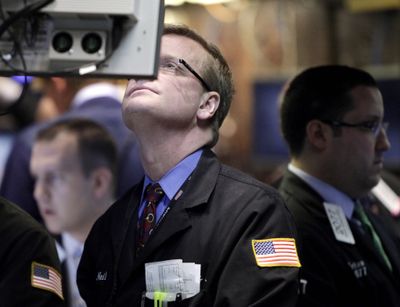April a stellar month
Wall Street numbers best in nine years; investors hope this is sign of turnaround

NEW YORK – April was Wall Street’s best month in nine years – offering some of the most powerful evidence yet that maybe, just maybe, the economy is about to begin a turnaround.
The Standard & Poor’s 500 index, considered the most reliable measure of the broader market, climbed 9.4 percent in April, its best performance since March 2000, the peak of the dot-com bubble. The Dow Jones industrial average shot up 7.4 percent in April, on top of a 7.7 percent gain in March.
That’s more than a relief for investors – it’s a potential economic indicator, because the stock market tends to get back on its feet before the economy does. In downturns over the past 60 years, the S&P hit bottom an average of four months before a recession ended and about nine months before unemployment hit its peak.
“The market is saying that the economy would hit its trough this summer,” said Al Goldman, chief market strategist at Wachovia Securities in St. Louis who has spent 50 years monitoring Wall Street.
Even with the gains in March and April, the Dow is still down 42 percent from its peak in October 2007, and the S&P 500 index is off 44 percent.
Nevertheless, the mood is clearly more upbeat.
Stocks mostly held steady Thursday, the same day that Chrysler filed for bankruptcy reorganization. Only two months ago, a more jittery market would have plunged if one of the Big Three said it couldn’t pay its bills.
On paper at least, U.S. stocks gained nearly $1 trillion in value in April alone. And the S&P’s March-April gain of 18.7 percent is its best two-month rise since 1975.
The hope among many investors and policymakers is that Wall Street itself will help the larger economy along. The same psychology that led many people to cut their spending following last fall’s frightening stock plunge could work in reverse, boosting confidence in the economy and making Americans feel more comfortable about spending.
The rally began in March when Citigroup surprised investors by announcing it had made money in the first two months of the year. Other banks followed suit, and last week many big banks posted results that weren’t as bad as feared. In April, economic readings on home construction, retail sales and orders for manufactured goods improved or at least didn’t slide as quickly as they did last fall.
This time, bank stocks, which led Wall Street to its devastating losses last year, are leading the market higher. Financial stocks in the S&P 500 index are up 74 percent since early March.
Of course, percentages can be misleading. The 200 percent gain in Citigroup’s stock in less than two months – from $1 to $3 – might not feel as rewarding for an investor who held the bank’s shares a year ago when they were worth $27. And the recovery in stocks is never a straight line upward; stocks could very well fall back somewhat.